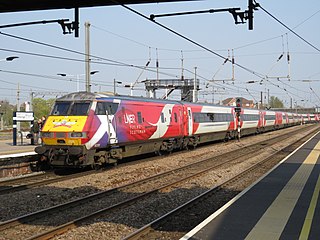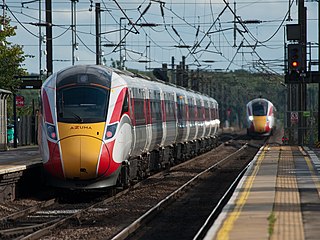
King's Cross railway station, also known as London King's Cross, is a passenger railway terminus in the London Borough of Camden, on the edge of Central London. It is in the London station group, one of the busiest stations in the United Kingdom and the southern terminus of the East Coast Main Line to Yorkshire and the Humber, North East England and Scotland. Adjacent to King's Cross station is St Pancras International, the London terminus for Eurostar services to continental Europe. Beneath both main line stations is King's Cross St Pancras tube station on the London Underground; combined, they form one of the country's largest and busiest transport hubs.

The LNER Class A4 is a class of streamlined 4-6-2 steam locomotive designed by Nigel Gresley for the London and North Eastern Railway in 1935. Their streamlined design gave them high-speed capability as well as making them instantly recognisable, and one of the class, 4468 Mallard, holds the record as the world's fastest steam locomotive. Thirty-five of the class were built to haul express passenger trains on the East Coast Main Line route from London Kings Cross via York to Newcastle, and later via Newcastle to Edinburgh, Scotland. They remained in service on the East Coast Main Line until the early 1960s when they were replaced by Deltic diesel locomotives; they themselves proving to be worthy successors to the A4s. Several A4s saw out their remaining days until 1966 in Scotland, particularly on the Aberdeen – Glasgow express trains, for which they were used to improve the timing from 3.5 to 3 hours.

The East Coast Main Line (ECML) is a 393-mile long (632 km) electrified railway between its southern terminus at London King's Cross station and Edinburgh Waverley via Peterborough, Doncaster, York, Darlington, Durham and Newcastle. The line is a key transport artery on the eastern side of Great Britain running broadly parallel to the A1 road. The main line acts as a 'spine' for several diverging branches, serving destinations such as Cambridge, Leeds, Hull, Sunderland and Lincoln, all with direct services to London. In addition, a few ECML services extend beyond Edinburgh to serve Glasgow Central, although the principal London-Glasgow route is the West Coast Main Line (WCML).

Morpeth is a railway station on the East Coast Main Line, which runs between London King's Cross and Edinburgh Waverley. The station, situated 16 miles 50 chains north of Newcastle, serves the historic market town of Morpeth, Northumberland, England. It is owned by Network Rail and managed by Northern Trains.

A Driving Van Trailer (DVT) is a British purpose-built control car railway vehicle that allows the driver to operate with a locomotive in push-pull formation from the opposite end of a train. A key benefit of operating trains with DVTs is the requirement for fewer locomotives; for example, a second locomotive would otherwise have to join at the other end of the train after arrival at terminal stations to lead the train's onward journey.

The InterCity 225 is an electric push-pull high speed train in the United Kingdom, comprising a Class 91 electric locomotive, nine Mark 4 coaches and a Driving Van Trailer (DVT). The Class 91 locomotives were built by British Rail Engineering Limited's Crewe Works as a spin-off from the Advanced Passenger Train project, which was abandoned during the 1980s, whilst the coaches and DVT were constructed by Metro-Cammell in Birmingham and Breda in Italy, again borrowing heavily from the Advanced Passenger Train. The trains were designed to operate at up to 140 mph (225 km/h) in regular service, but are limited to 125 mph (200 km/h) principally due to a lack of cab signalling and the limitations of the current overhead line equipment. They were introduced into service between 1989 and 1991 for intercity services on the East Coast Main Line (ECML) from London King's Cross to Leeds, York and Edinburgh.

The Silver Jubilee was a named train of the London and North Eastern Railway (LNER) that ran between 1935 and 1939.

The Flying Scotsman is an express passenger train service that operates between Edinburgh and London, the capitals respectively of Scotland and England, via the East Coast Main Line. The service began in 1862 as the Special Scotch Express until it was officially adopted in 1924. It is currently operated by the London North Eastern Railway.

4464Bittern is a London and North Eastern Railway (LNER) Class A4 steam locomotive. Built for the LNER and completed on 18 December 1937 at Doncaster Works as works number 1866, it received number 4464. After that it was renumbered 19 on 16 August 1946 under the LNER 1946 renumbering scheme, and finally 60019 by British Railways on 10 October 1948, after nationalisation. Of the 35 strong class, it is one of six to survive into preservation but it is one of only two currently scheduled to be certified for mainline use.

Durham is a railway station on the East Coast Main Line, which runs between London King's Cross and Edinburgh Waverley. The station, situated 14 miles 3 chains south of Newcastle, serves the cathedral city of Durham in County Durham, England. It is owned by Network Rail and managed by London North Eastern Railway.

Darlington railway station is on the East Coast Main Line serving the market & industrial town of Darlington, County Durham, England. It is 232 miles 50 chains north of London King's Cross. It is situated between Northallerton to the south and Durham to the north. Its three-letter station code is DAR.
The Coronation was a streamlined express passenger train run by the London and North Eastern Railway between London King's Cross and Edinburgh Waverley. Named to mark the coronation of King George VI and Queen Elizabeth, it was inaugurated on 5 July 1937. The down train (northbound) left London at 4 pm and arrived in Edinburgh at 10 pm; the up train (southbound) ran half an hour later.

Reston is a railway station in the small village of Reston that serves the wider rural parish of Coldingham and nearby small town of Eyemouth in the eastern Scottish Borders council area. The station is a minor stop on the East Coast Main Line and opened on 23 May 2022 after a £20 million investment. The station is owned by Network Rail and managed by ScotRail, although the latter company does not provide any services to or from the station. It is the second railway station to have been located in the village, having replaced an earlier station that closed in 1964.

The British Rail Class 800, branded as the Intercity Express Train (IET) by Great Western Railway (GWR) and Azuma by London North Eastern Railway (LNER) is a type of bi-mode multiple unit train built by Hitachi Rail for GWR and LNER. The type uses electric motors powered from overhead electric wires for traction, but also has diesel generators to enable trains to operate on unelectrified track. It is a part of the Hitachi AT300 product family.

The British Rail Class 801 Azuma is a type of electric multiple unit (EMU) built by Hitachi Rail for London North Eastern Railway. The units have been built since 2017 at Hitachi's Newton Aycliffe Manufacturing Facility and have been used on services on the East Coast Main Line since 16 September 2019. As part of its production, the Class 801 units were ordered as part of the Intercity Express Programme and are in the Hitachi AT300 product family, alongside the closely related Class 800 units. LNER have branded the units as the Azuma, just like on their Class 800 units.

London North Eastern Railway (LNER) is a British train operating company. It is owned by DfT OLR Holdings for the Department for Transport (DfT). The company's name echoes that of the London and North Eastern Railway, one of the Big Four companies which operated between 1923 and 1948.

In the English speaking world, Carolean era refers to the reign of Charles II (1660–1685) and usually refers to the arts. It is better known as The Restoration. It followed the Interregnum when there was no king. The period was noted for the flourishing of the arts following the demise of The Protectorate. It ended with the Glorious Revolution of 1688 when James II of England & VII of Scotland went into exile.

The coronation of Charles III and his wife, Camilla, as king and queen of the United Kingdom and the other Commonwealth realms, took place on Saturday, 6 May 2023 at Westminster Abbey. Charles acceded to the throne on 8 September 2022 upon the death of his mother, Elizabeth II. It was the first coronation held since Elizabeth II’s coronation in 1953 nearly 70 years prior.

















